Did You Know? Oyster Dating

Source: Jessica Winder
Oyster shells have rings, much like tree rings, which give clues about oyster growth and age. Scientists can use local conditions (i.e. environmental clues - cold winters with slow growth and a dense age ring, warm summers with faster growth and a less dense ring) to determine the age of the oyster. For example: in the image, one thick, darker section and one thinner, white line would represent one year of growth - a summer growing season and a winter growing season. Scientists also study age in oysters by monitoring growth from its spat stage through a set amount of time, monitoring and measuring growth along the way. This method is useful for determining environmental data for an area - using weather conditions over the growth period to infer which growth rings occurred during specific conditions.
The mineral content in oyster shells also reflect mineral content of the ocean. Scientists can use fossil oyster shells to examine historic ocean conditions.